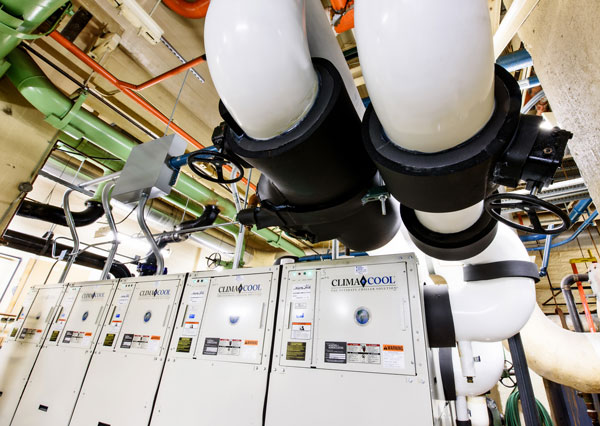When it comes to boosting a building’s energy efficiency, it isn’t always about doing more with less. In fact, often the key is in using exactly the amount of energy that’s needed—and not a kilowatt-hour more.
That was the case for the PNC Bank Building in Toledo, Ohio. Originally opened in 1930, today it houses accounting firms, law offices, and a restaurant. The building’s HVAC equipment was efficient when it was running at full capacity, but it wasted resources when the 29-story building was only partially occupied, or during off-peak times.
So when the 56-year-old centrifugal chiller system fell into disrepair in October 2014, it was the perfect opportunity to find a more flexible cooling solution. Building manager Richard Stiff worked with JDRM Engineering to conduct an energy study and evaluate options for a replacement chiller.

Before ClimaCool’s work, the 29-story building’s HVAC equipment was efficient when running at full capacity, but energy was wasted during off-peak hours. Photo: Courtesy of ClimaCool
Stiff’s primary goals were twofold: increasing energy efficiency and cutting costs. By analyzing building usage and consumption needs, JDRM determined that the restaurant was the only area in need of cooling during off hours—nights and weekends. The old 350-ton system wasted energy outside business hours, as well as during the spring-summer start-up period and fall-winter changeover days. As Tim Sandys, co-owner of HVAC firm Sandys & Associates, puts it: “Why run 350 tons on nights and weekends when you only need 80 tons to get the job done?”
That central question led JDRM and Stiff to a solution in the form of a modular chiller from ClimaCool. Unlike conventional chillers, it has separate electric feeds for individual units, improving the turndown capacity. While the chiller functions as one piece of equipment, the five 85-ton units can be controlled separately. Thus, the 425-ton machinery is powerful enough to cool the entire building on peak days, but it can also be turned down to power one or two units.
In other words, the modular chiller allows management to only use the energy that’s needed. And that flexibility has resulted in major savings: effective turndown has resulted in energy reduction of 375,000 kilowatt-hours annually, plus an annual savings of $42,000.
The modular nature also facilitates preventive maintenance, one of Stiff’s major priorities. Unlike some competitors’ chillers JDRM considered, which require operators to shut down the entire system to repair one module, ClimaCool elements can be isolated. “We chose this unit because it offered true redundancy,” Stiff says. “If we had to service one of [the modules], then the other modules could stay operational.”
This is a major benefit, Sandys adds, as “the owner’s tenants never have to be without cooling, even when the chiller requires service.” Not that the system requires extensive servicing. Once a year, Stiff’s team will clean out any debris that collected during the season. But when that happens, cooling isn’t interrupted.
“With the ClimaCool modular design and individual power wiring, it is almost impossible to have the entire chiller system shut down,” Sandys says.

375,000kWh annually saved thanks to only using the ClimaCool modular chiller when it’s actually needed; $42,000 of energy savings per year; photo: courtesy of ClimaCool
The system selects a different compressor to run each time, helping to equally balance the operating hours between the units. Stiff explains that his team can start the chillers from a remote point. “The Honeywell unit can identify how many compressors we need to have running. It reduces the demand and the capacity of the building, and the energy consumption over time,” he says. In addition, Stiff is able to maintain tight control over the chiller’s water temperature, keeping energy consumption very low, Sandys says.
The installation process, which was completed in the spring of 2015, was also facilitated by the chiller’s modular design. It fit easily into the limited space—and there was no need to tear out a wall to install a large centrifugal unit. Once installed, it was easy to integrate into the existing building communication system. Additionally, Stiff, who has maintained the building since 1981, was able to customize the cooling to meet occupants’ needs.
After the successful installation and operation of the new system, Stiff is a strong advocate for modular chillers, saying they offer benefits conventional chillers can’t match. Apart from the added efficiency, the longtime facilities professional can’t say enough about the durability of the new system. In fact, he describes the benefits in just three words: quality, performance and longevity.
Download a PDF of this story here.
Connect with ClimaCool: Website | Facebook | Twitter



